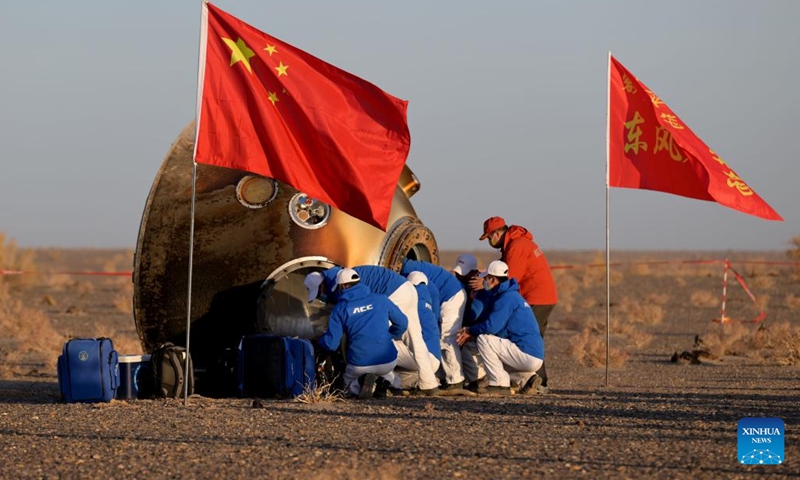Shenzhou-16 crew returns to Earth after 154 days in space
First manned mission in space station application and development stage a complete success: commander

The return capsule of the Shenzhou-16 manned spaceship touches down at the Dongfeng landing site in north China's Inner Mongolia Autonomous Region, Oct. 31, 2023.(Photo: Xinhua)
In a monumental achievement for China's manned space program, the return capsule of the Shenzhou-16 manned spacecraft has successfully returned to Earth after a historic mission that lasted 154 days in space.
According to the China Manned Space Agency (CMSA), the craft landed at the Dongfeng Landing Site at 8:11 am on Tuesday, with the on-site medical team confirming that the three taikonauts onboard led by mission commander Jing Haipeng were in good health. This marks the successful completion of the first manned spaceflight mission since China's Tiangong Space Station entered the application and development stage.
The Shenzhou-16 crew safely finished exiting the return capsule at 9:10 am, per the CMSA.
Jing, who has executed four space journeys with the completion of the latest Shenzhou-16 mission, a record in the country's space program, described the 154-day time in space as "happy and highly efficient" when he came out of the capsule.
According to the veteran taikonaut, who has spent more than 200 days in space across different missions, the Shenzhou-16 mission was a complete success that had made "zero errors and zero mistakes."
"We turned the hard work, sweat, intelligence and dreams of researchers into reality. This is the result of the combined efforts of the space and ground participants, and the unity of the crew," Jing said.
After exiting from the capsule, Zhu Yangzhu, who participated in the mission as China's first-ever spaceflight engineer, said that he hoped to recover soon so he could join a future space mission again.
Gui Haichao, the country's first civilian taikonaut who served as the payload expert on the Shenzhou-16 mission, disclosed after landing that all the experiment and research projects in space went well.
The CMSA told the Global Times on Tuesday that the mission is greatly significant as the three types of taikonauts that China has currently passed their flight assessments and practical tests during the mission, which lays a solid foundation for the future development of the program and large-scale space science experiments.
Subsequently, the spacecraft's return propulsion engine was ignited, the return capsule separated from the propulsion module and landed successfully. The search and rescue team responsible for the mission promptly identified the landing site and arrived on scene.
Along with the return of the Shenzhou-16 crew were samples from 19 scientific experiments that had been brought to space for various studies, including liver cells, proteins and nucleic acids, and seeds of rice and thale cress, weighing a total of around 25 kilograms.
The life science experimental samples have been transported to Beijing and delivered to the Technology and Engineering Center for Space Utilization of the Chinese Academy of Sciences on Tuesday afternoon, after which it will be checked and handed over to experimental scientists for further research, the Global Times learned from the academy.
According to mission insiders, the Shenzhou-16's journey back to Earth used a rapid return maneuver similar to those used since the Shenzhou-13 mission and took around seven and a half hours, a significant cut from the previous method that took some 30 hours during the Shenzhou-12 mission.
This improvement not only further enhances return efficiency, shortening ground monitoring, but also makes it more comfortable for the taikonauts, mission insiders explained.
The Shenzhou-16 was launched into space on May 30, from the Jiuquan Satellite Launch Center in Gansu Province before it docked with the space station.
The first batch of taikonauts to carry out a manned mission in the space station's application and development stage, the three taikonauts carried out one spacewalk and China's fourth Tiangong Space Lecture Session. They also assisted in multiple cargo egress missions from the space station, laying the groundwork for the routine implementation of future missions.
With close cooperation between the taikonaut crew and ground research staff, numerous space science experiments were conducted in areas such as ergonomics, space medicine, life ecology, biotechnology, material science, fluid physics and space technology.
Significant progress was made in the fields of space life science and human research, microgravity physics and new space technologies. This mission signifies an important step in the transition of China's manned space program from construction to application and from investment to returns, the CMSA said.
Before the Shenzhou-16 separation from the space station, the Shenzhou-16 crew conducted a handover with the new Shenzhou-17 crew, sharing their work experience with the newcomers and completing transfer and installation of supplies and returning samples.
During the spacecraft's flyby after separation, the Shenzhou-16 crew used a high-definition camera to take a panoramic shot of the space station with the Earth in the background, according to the CMSA.
Having completed the Shenzhou-16 mission, the three taikonauts safely arrived in Beijing on Tuesday afternoon. They will enter a routine quarantine and recovery period where they will undergo comprehensive medical check-ups and health assessments and get some rest.

